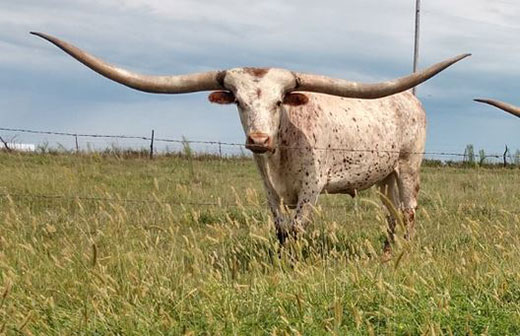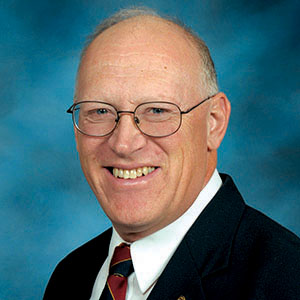
Lazy J Longhorn steer (Courtesy photo)
Kansas Profile – Now That’s Rural: Joe Sedlacek, Lazy J Longhorns
Dec. 29, 2021
By Ron Wilson, director of the Huck Boyd National Institute for Rural Development at Kansas State University
A crew from the Guinness Book of World Records is recording a video of a new world record holder. And where do you suppose this world record holder is found? Would you believe, in rural Kansas?
Today we’ll meet a family which is producing longhorn cattle that are setting global records.
Joe Sedlacek is the owner of Lazy J Longhorns near Greenleaf, Kan. He was born in the nearby rural community of Frankfort, population 726 people. Now, that’s rural.
Joe grew up around cattle as his father ran an Angus cowherd. But Joe became interested in another kind of cattle: Texas longhorns.
“I was always fascinated with longhorns,” Joe said. “I’d watch every old western just to catch a glimpse of a longhorn. If we were traveling and happened to see a longhorn, we’d have to stop and take a picture.”
In August, 1996 when Joe was 15, he bought three longhorns as a hobby. “By Christmas of that year, I had 50 head,” Joe said. That is definitely a hobby that grew. After graduation, Joe did accounting work to keep books for several companies while growing his longhorn herd.
“Those book-keeping skills would come in handy (for the longhorn business) because you have to track a lot of data and measurements,” Joe said. In 2005, he married Stephanie who had grown up in nearby Hanover. They bought ground and built a home near Greenleaf.
“I figured this could be a viable business if I could devote myself to it full-time,” Joe said. In 2008, he left another job to concentrate on his registered Texas Longhorn cattle breeding business. He called it Lazy J Longhorns.
Today, Lazy J Longhorns has approximately 150 head of longhorns. Lazy J sells longhorn bulls, cows, steers and heifers as well as a specially designed working chute.
The longhorn breed has rich history. After the Civil War, these hardy animals were running free in Texas, yet there was high demand for beef in the eastern markets. Entrepreneurial Texans gathered those longhorn cattle and drove them north to railroads in Kansas where they could be shipped to markets in the east. Of necessity, those animals learned to survive and raise calves in harsh wilderness conditions. Those traits of hardiness and mothering ability remain with the breed today.
The greatest fascination is with the huge horns that grow naturally on the heads of both males and females. Breeders are continually seeking to raise cattle with longer horns. The Texas Longhorn Breeders Association of America even conducts an annual Horn Showcase and sale with prizes for the animals with the longest horns.
“Buyers want the big horns. If an animal has distinctive color and good disposition, that adds to the value even more,” Joe said.
One year, Joe’s herd raised a blue roan colored steer that he named Lazy J’s Bluegrass. The steer grew to have horns that were 10 feet 2 inches long, a world record at the time. In fact, Lazy J’s Bluegrass won the world record three years in a row.
Not only did the longhorn set the world record in the Guinness Book of World Records, he was chosen to be one of only 10 world record holders for which Guinness sent a video crew to record his story.
Lazy J’s Bluegrass became quite the celebrity. Joe brought him to Fort Worth for the annual longhorn sale and posted a video of Bluegrass walking into his pen on Wednesday evening. By the time of the sale on the following Friday night, the video had reached 4 million hits. On that night, Lazy J’s Bluegrass sold for a record $48,000. “The horn race is definitely on,” Joe said.
For more information, see www.lazyjlonghorns.com.
A video crew came to Kansas and recorded footage of Lazy J’s Bluegrass, the world record-setting longhorn steer. We commend Joe and Stephanie Sedlacek for making a difference with their commitment to this unique breed. The legacy of these cattle is truly long.
And there’s more. Remember the specially designed working chute? We’ll learn about that next week.
Audio and text files of Kansas Profiles are available at http://www.kansasprofile.com. For more information about the Huck Boyd Institute, interested persons can visit http://www.huckboydinstitute.org.
***
The mission of the Huck Boyd National Institute for Rural Development is to enhance rural development by helping rural people help themselves. The Kansas Profile radio series and columns are produced with assistance from the K-State Research and Extension Department of Communications News Media Services unit. A photo of Ron Wilson is available at http://www.ksre.ksu.edu/news/sty/RonWilson.htm. Audio and text files of Kansas Profiles are available at http://www.kansasprofile.com. For more information about the Huck Boyd Institute, interested persons can visit http://www.huckboydinstitute.org.


